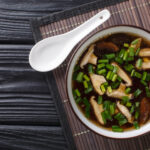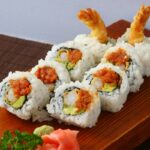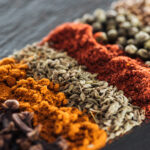One foodstuff that is increasingly popular in Japan is tempura. These deep-fried seafood, meats, or vegetables are created by typically frying them in a large amount of vegetable oil or canola oil.
Traditionally, tempura was made by being deep-fried in sesame oil which has since gone out of fashion. If you want to create a more authentic taste for your deep-fried Japanese cuisine, you may want to mix up your oils while frying.

In this article we will look at the cooking oils which are used for frying in Japan, whether you can mix oils when frying, and the types of oils that mix well.
The Cooking Oils Used For Frying In Japan
While there are people that will be stringent about the extra virgin olive oil that goes over their carefully prepared salad, they are less fussy when it comes to the cooking oil for Japanese cooking.
Though a lot of cooking books will simply say ‘vegetable oil’ as an indication of what you should use for frying, they should be more specific. Anyone using vegetable oil for cooking Japanese food should look at what the oil is comprised of.
Better still, head to an Asian supermarket and look at what they have to offer as you could get a bargain by buying in bulk.
The vegetable oil used for frying food in Japan tends to be derived from various sources. Not only is it typically made from around 14 different plants, about 40% is from canola oil, another 30% from soybean, and a further 15% from oil palm. The remaining components in vegetable oil are from olives, safflowers, coconuts, rice, and corn.
Though you can buy specific tempura oil which is from Japan in an Asian supermarket it tends to be unnecessary and expensive when compared to the oils you can use just as well.
Already you can tell that the vegetable oil used for frying Japanese food tends to be a mixture in itself, you can create your own mix if you want to.
Can You Mix Oils When Frying?
The peanuts used in peanut oil tend to be one of the most recognized and celebrated oils for frying as it tends to only burn at a high temperature of around 450 to 500°F.
Peanut oil also fails to pick up any taste like many other oils can so you can get extra value by straining and re-using it which is one reason why it is so popular in Japan.
For a truly authentic Japanese taste, you should use a good cooking oil such as peanut oil and then mix some Japanese or Chinese sesame oil. This sesame oil should make up 10% of the total so will not overpower the peanut oil but introduces a nice variation for the overall taste.
Everyone has their own preference yet if you want some guidance on whether to mix oils when frying, take the lead from some chefs.
Typically, a blend of oils can be used when creating some tasty flavor blends and this is especially true if you are using an oil that you may find overpowering on its own.
A cooking oil such as sesame oil may prove too much so you can mix in a less powerful one, such as vegetable oil, to dilute it.
If you do decide to mix oils when frying, bear in mind the smoke point (also known as the burning temperature). Let’s say that your oil blend is 90% coconut oil, you should be wary that the smoke point of coconut oil is 350°F which is 100°F less than that of peanut oil.
When pan-frying, you should expect the temperature to rise to between around 325 and 400°F so ensure that the oil you are using has a higher smoke point. It is even easier to work out if the oils you are mixing are all of a similar smoke point.
The Types Of Oils That Mix Well
As we have established, if you are mixing oils then you should check the smoke point of each one first. Ideally, each oil has a smoke point of around 50°F of each other otherwise it can get stressful when you see smoke or flames and whatever you are frying is not quite done.
Some of the best oils for frying, whether pan-frying or deep-frying, have a smoke point of over 400°F. These include refined avocado oil (520°F), rice bran oil (490°F), and light olive oil (465°F).
A lot of chefs tend to use vegetable oil as the bulk and base ingredient of a deep-frying mix. They tend to know the desired flavor of their deep-frying oil so mix in other oils to specific quantities.
A trio of vegetable oils that work well together due to their similar smoke point are sunflower oil (400°F), canola oil (400°F), and corn oil (450°F).
Final Thoughts
When you are pan-frying or deep-frying, you should be conscious of the cooking oil that you are using. Make sure that you research the smoke point so that bigger pieces of food can be consistently fried and cooked without smoke or fire being created.
You can mix cooking oils together when frying but make sure that the smoke points of each one are within around 50°F of each other. If you use one oil with a lower smoke point, especially as your base, then you do risk reaching that smoke point and setting off an alarm.
Frequently Asked Questions
Which Cooking Oils Should Not Be Mixed For Frying?
Oils that have a comparatively low smoke point are not ideal for frying. This is largely down to how readily they will give off smoke before fully cooking whatever you are wanting to cook.
There is also the added risk of fire, smoke, and harmful compounds getting in your food. If you are deep-frying food then steer clear of butter (300°F), extra virgin olive oil (325 to 375°F), unrefined sesame oil (350°F), and duck fat (375°F).
Which Cooking Oils Do The Japanese Use When Creating Tempura?
In Japan, canola and vegetable oils are popular and the most commonly used for cooking. However, the traditional cooking oil for creating tempura is sesame oil.
If you were to visit a Asian supermarket or traditional Japanese grocery store chances are you would be advised to get sesame oil or even a tea seed oil.
The thinking behind these oils is that certain compounds included in them can aid in creating a crispier and lighter batter which is ideal for tempura.
If you enjoyed this post, you might enjoy our article on ‘How Much Does Ramen Cost?‘.
- 16 Best Websites To Watch Japanese Movies With English Subtitles - May 11, 2023
- Is ZIPAIR The Best Airline For Traveling To Japan? - May 11, 2023
- Ryu Murakami Vs Haruki Murakami – Which One Should You Read? - May 11, 2023





![What Sushi Has No Fish? [Vegetarian Sushi Explained] What Sushi Has No Fish? [Vegetarian Sushi Explained]](https://justaboutjapan.com/wp-content/uploads/2023/03/What-Sushi-Has-No-Fish-Vegetarian-Sushi-Explained-150x150.jpg)


